It looks like time to say farewell to the Decameron. The Decameron has been the place for new thinking, observation, letters from friends and art and we’ve been very proud of that. We’re now closed to new posts but if you want to get in touch please email me, angus.bancroft@ed.ac.uk
Category: Decameron Stories
There are many stories being told, in private and in public, about experiences of the lockdown. There are stories of boredom, illness, death and grief, but also of, waiting, of community, of humour and of hope. Who is telling these stories and how? Whose experiences are we not hearing about? It is important to record all the many differences as well as commonalities in experience that exist, and also to recognise that who records these and how they do so makes a significant difference. #decameronstories
If you’ve got an idea for a contribution please email mary.holmes@ed.ac.uk
I haven’t shaved since lockdown
Giulia Cavalcanti
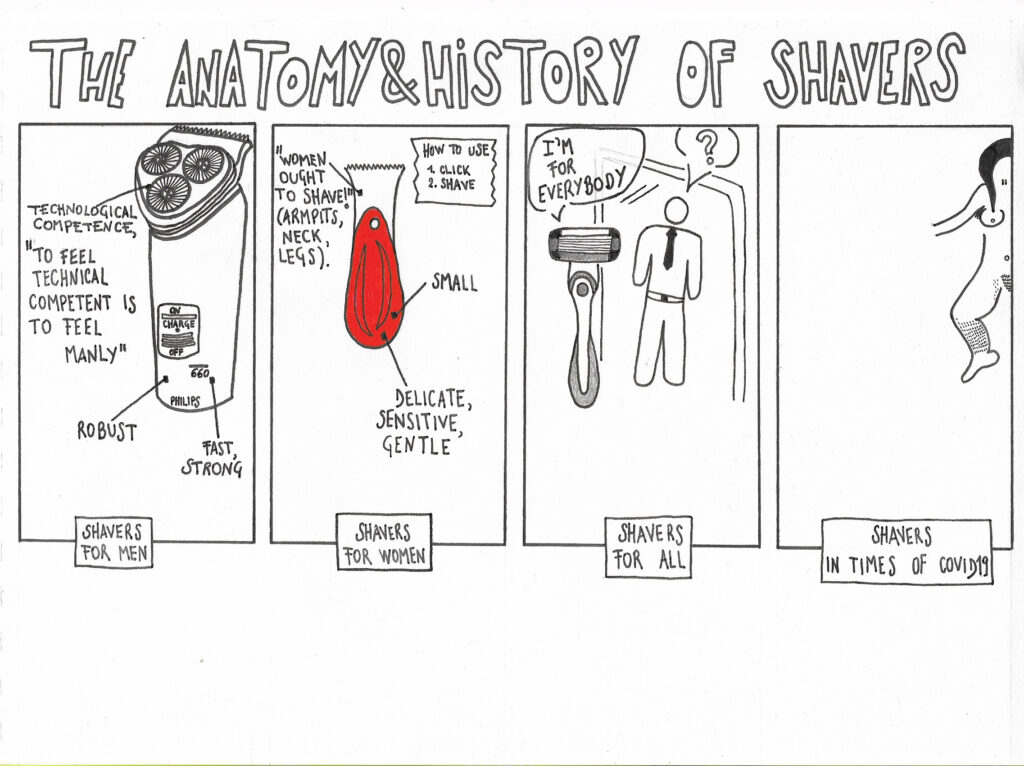
Today I will tell you the anatomy and history of electric shavers from 1920 until today, or better known as Corona times.
Shavers came into the world for men. Designed by men for men. Black, robust, strong, fast, and with visible screws. That is how electric shavers for men were and still look like (van Oost, 2003: 198-9). As sociologists, we are all well aware that material goods are used to construct and perform one’s gendered identity (van Oost, 2003: 194). This electric shaver advert from the 1990s targeted to men says it all. Meanwhile the manly voice talks, the song sings “for the men inside”. These features – robust, strong, fast, technological competent – are the features that make men manly. Masculinity, however, was not built from scratch starting from electric shavers. Designers and adverts have simply reinforced the meaning of being a man through the symbolic features of electric shavers ‘for men’. For instance, the visible screws told men that they are technologically competent (van Oost, 2003: 198-9, 207).
Then, shavers for women came into the world. For women, but yet still designed by men. Pink, small, delicate, sensitive, gentle. That is how electric shavers for women were and still look like. This was the understanding that designers – male designers – had around femininity. Small, delicate, sensitive, gentle ‘electric shavers for women’ alongside their adverts — such as this – have reinforced the meaning of being a woman (van Oost, 2003: 200-7). Furthermore, the manly voice in the advert gives us a tip. He says: “made for women with men in mind”. Simply put, women ought to shave for the pleasure of men. And this is how women’s generation after generation dedicated their times to remove their body hair to avoid men from having the haunting sight of a hairy woman, meanwhile hairy men became sexier and sexier…
Eventually, millennials came into the world and rejected the gendered products, including shavers. Designers and adverts had to respond, and eventually, gender-neutral shavers came into the world. Shavers ‘for you’, shavers ‘for all’… But how neutral are they? If we take a closer look and compare those “revolutionary” (feel the sarcasm) shavers and compare them to the old-fashion ‘shavers for men’, it can be easily argued that gender-neutral shavers or any other “neutral” material good, are made having in mind as possible target men, exactly because designers are mostly male (van Oost, 2003: 196).
Products have changed, but not shaving practices, especially among women. Until finally, coronavirus or scientifically speaking COVID-19 came. Coronavirus has contributed to making the poor poorer, black deaths, working-class peoples’ deaths, increased housework and childcare labour for women…. But we, or at least I, cannot deny that coronavirus freed us all from few gendered social norms.
I haven’t worn a bra since lockdown.
I haven’t used make-up since lockdown.
I haven’t shaved since lockdown.
My neck, armpits, and legs are uncovered. It is summer. And yet I still have not shaved since lockdown. Has coronavirus revolutionised women’s shaving practices? The answer is no. I haven’t shaved since lockdown. Until I decided to go to Portobello beach to swim with my friends. Since then my body hair has grown, and I haven’t shaved since.
Yet, my neck, armpits, and legs continue to be uncovered. So, why have I shaved when I wore a bikini and not when I wear trousers that show my hairy legs? I wish I could say that the answer is laziness. Lazy to shave. Rather, one of the possible answers might be the fear of drawing attention. A female hairy body draws more attention than a shaved one. And drawing attention means having eyes at you. I shaved to not draw attention to my body, to limit the eyes of those who may look at my body. Because most than often drawing attention to a body ends in the sexualisation of it.
Let me tell you a story. I went to the Meadows and wore 80s trousers. For fashion lovers: black and white striped trousers. And a tight basic blacktop. I chose to wear those trousers despite my hairy legs, but I chose to wear a bra (remember: I haven’t worn a bra since lockdown, no matter if at home, or outside).I chose to show my hairy legs, but I chose to hide my nipples. Calves, in my heterosexual viewpoint, are not sexy. Calves are not sexual per se. Women’s nipples are.
This is when choosing what to wear for a simple walk at the meadows with a friend becomes a sociology class. So, what has led me to step outside the door of my house wearing a bra? I chose my outfit. I tried it on. And I saw my nipples. So far so good. But then, a body sensation filled my whole body. Anxiety. Fear. Of what? – you may ask. Fear of being sexualised. Fear of the eyes of those who may sexualise free nipples. This was the same fear and anxiety that led me to shave my legs before going for a swim at the beach.
The truth is that I shaved when I wore a bikini to protect myself. The truth is that I wore a bra to protect myself. The ugly truth is that women juggle between making themselves sexual beings and desexualise themselves to avoid over-sexualisation anytime, anywhere by anyone.
Let me tell you a final little story. The other day was the birthday of my friend, and we celebrated at the Meadows, once again. I wore a loose green shirt. I also chose to not wear a bra, despite being able to see my nipples and the shape of my breast at the mirror. I did it on purpose. Apart from a few drinks, I wanted to go back home with a sociological self-reflection. And I did. After all, I did not feel sexualised by anyone, including by the strangers that I encountered in the streets.
So, what was all the fuss about – you may ask? The ugly truth is that women and girls are taught that danger is everywhere, you must never let the guard down…
Covid-19, or corona as we informally call this killing virus, has not revolutionised women’s shaving practices. Women are simply standing against the gendered norms, as far as they, we, feel safe to do so. As far as rape culture will be round and about, hidden as coronavirus, around the streets and houses of the world, women’s revolution will not be completed.
Sources
van Oost, E. C. J. (2003). Materialized gender: how shavers configure the users’ feminity and masculinity. In N. E. J. Oudshoorn, & T. Pinch (Eds.), How users matter. The co-construction of users and technology (pp. 193-208). Cambridge, Massachusetts: MIT Press.
Rainbow Series – Day 7: The Peacock and the Path to New Beginnings


As we approach a zero-covid Scotland, let us not forget the hard-learnt lessons, the lives lost and the promises made for new beginnings. Let us dare to dream a better, brighter future where kindness and empathy, and radical care and solidarity are at the centre of human interactions.
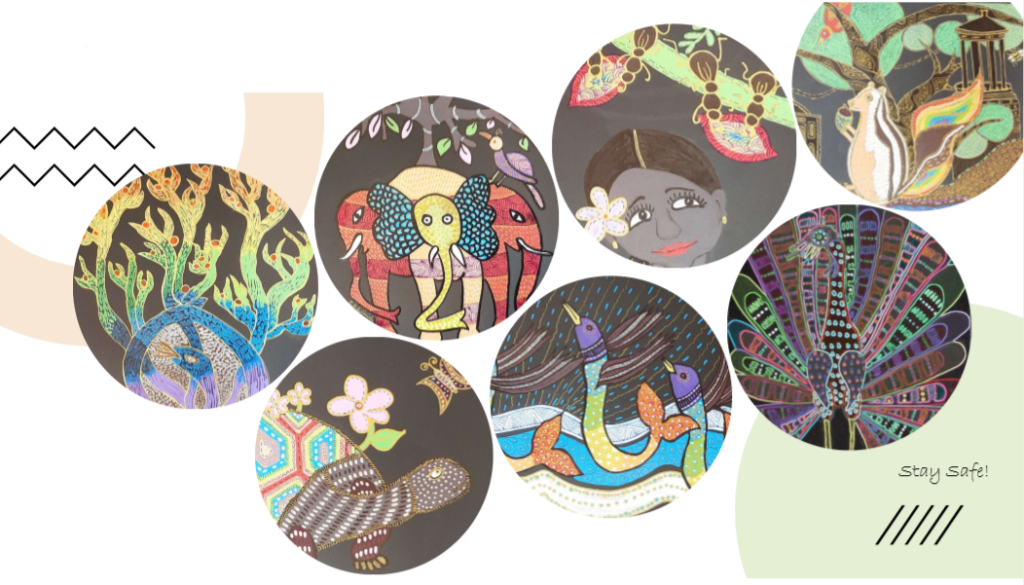

Radhika Govinda is a feminist sociologist whose work is on the gender politics of development, intersectionality and feminist knowledge production. She lives and works in Edinburgh, and can be reached at Radhika.Govinda@ed.ac.uk. Twitter: @GovindaRadhika
Rainbow Series – Day 6: The Squirrel’s Message

As someone who was born and brought up in India but is now living and working in Scotland, I have always tried to hold in the same frame my two worlds. But keeping in touch across different time zones and caring long distance for loved ones has not been easy. In some ways, the outbreak of covid-19 and especially India having sealed its borders from even Indian passportholders living abroad has been anxiety-inducing in that it forecloses even the possibility of travel were the need to arise. But in other ways, the pandemic has brought together my two worlds which are otherwise worlds apart. At times, the appalling inadequacy of state response has made me wonder if I am really living in a ‘developed’ country. At other times, I have chosen to focus on how the pandemic has strengthened old bonds of family and friendship (we are connecting a lot more on skype/whatsapp while balancing working from home with childcare) and opened up new windows (of time and space) for radical care and solidarity (through webinars and accelerated transnational activism). Each time I fret about what the future holds, I remind myself that, beyond the corona lens, the tree of life continues to grow and life-sustaining water continues to flow through the two places (Delhi represented by Qutab Minar and Edinburgh symbolised by Calton Hill in the painting) at the centre of my phenomenological world.


Radhika Govinda is a feminist sociologist whose work is on the gender politics of development, intersectionality and feminist knowledge production. She lives and works in Edinburgh, and can be reached at Radhika.Govinda@ed.ac.uk. Twitter: @GovindaRadhika
Rainbow Series – Day 5: Awesome Ants and the Why-Why Girl

‘Awesome ants and the why-why girl’*
Since the start of the pandemic, I’ve been having rather vivid dreams. In one, I was in a mask-making factory and was stitching masks alongside hundreds of factory workers. In another, all human beings had a piece of the jigsaw puzzle and if we worked together to solve it, we would find the vaccine for covid-19…. The dreams are no doubt bizarre and waking up from them I am exhausted the next day but I’m convinced that working hard and working together, as people seem to do in my dreams, is the only way we can all make it! How many lives must be lost before this is understood?!
*I’ve taken inspiration for the title and some of the designs in this artwork from two of my son’s storybooks, Mahasweta Devi’s (2003) The Why-Why Girl, Chennai: Tulika, with illustrations by Kanyika Kini, and Vinitha’s (2018) Sara Learns To Fly, New Delhi: Katha, with illustrations by Nirzara Verulkar.
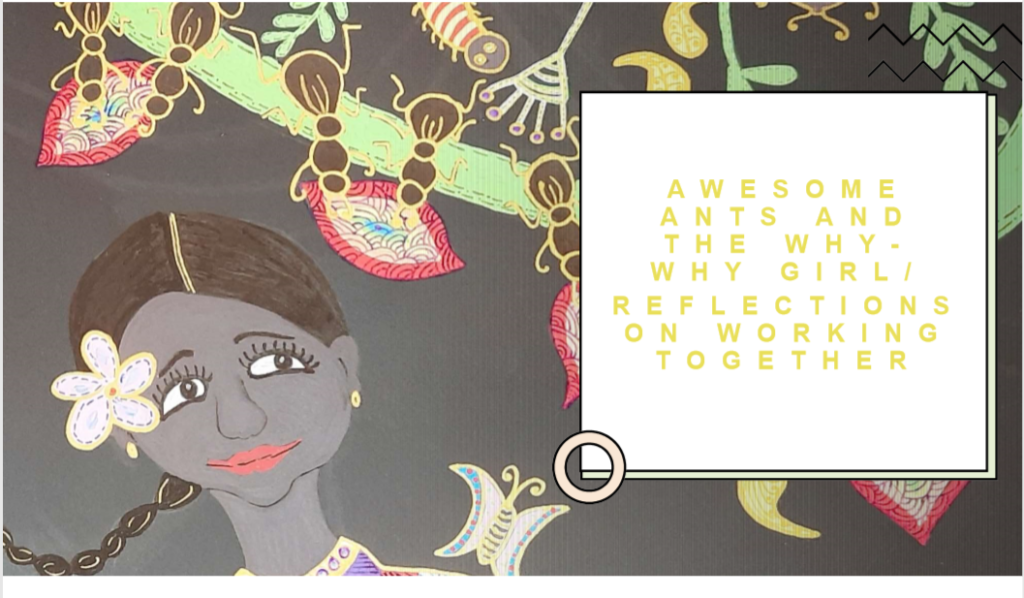

Radhika Govinda is a feminist sociologist whose work is on the gender politics of development, intersectionality and feminist knowledge production. She lives and works in Edinburgh, and can be reached at Radhika.Govinda@ed.ac.uk. Twitter: @GovindaRadhika
Rainbow Series – Day 4: Out of the Fishbowl

‘Out of the fishbowl!’
Why couldn’t the British, US and Indian governments take prompt and appropriate action to curb the spread of the virus? Why do they continue to prioritise economic gain over the well-being of people? I have felt angered and aghast at the sheer refusal by political leaders to see the big picture! Why can’t they put aside petty politicking over who will have access to consignments of masks, hydrochloroquine and remdesivir? Why are people hoarding toilet rolls? Why are domestic workers being ostracised as being carriers of the virus in India? Why is there BAME disproportionality in doctors and nurses’ deaths in the UK? The virus has shown that it does not respect boundaries but we as nations and individuals seem to be holding onto and reproducing them against all good sense…. In gond art, fish are depicted as having wings and as moving forward together in shoals. Why can’t we too respond by adapting to the changed circumstances and by showing radical solidarity in the stormy times of covid-19!


Radhika Govinda is a feminist sociologist whose work is on the gender politics of development, intersectionality and feminist knowledge production. She lives and works in Edinburgh, and can be reached at Radhika.Govinda@ed.ac.uk. Twitter: @GovindaRadhika
Rainbow Series – Day 3: Empathetic Elephants


Elephants are known to be kind and empathetic. After the first month or so of lockdown in Edinburgh, my mind has kept going back to how important it is for us to reconnect with nature, and to be attentive to the simple lessons that birds and animals have long known, lessons we seem to have forgotten as we have evolved: about kindness and empathy, about living in harmony with one another and with nature…. As the weeks have turned into months in lockdown, my family and I have valued the opportunity to spend time outdoors, albeit initially limited to our back garden and the meadows. In more recent weeks, we have been able to go hill walking, and my 4.5 year old has learnt to climb trees (a skill I suspect he wouldn’t have otherwise learnt given our urban lifestyle) and as I pick a flower or two on our walks he insists that I not pick the ones that the bees would miss! I hope we’ll remember to carry with us these learnings into a future free from the spectre of covid-19. If the rise in racial violence points to the dire need to embrace these learnings, the mutual aid groups that have been formed offer a ray of hope.

Radhika Govinda is a feminist sociologist whose work is on the gender politics of development, intersectionality and feminist knowledge production. She lives and works in Edinburgh, and can be reached at Radhika.Govinda@ed.ac.uk. Twitter: @GovindaRadhika
Rainbow Series – Day 2: Spring is Here

‘Spring is here!’
The first few weeks in the lockdown were a whirlwind of activity and anxiety. I had neither the time (what with balancing full time working from home with childcare) nor the courage to step out (so afraid I had felt of the deadly virus). When I finally set foot outside after four weeks, I realised that spring had already arrived while I had been trying to make sense of the new normal! The flowers were in bloom. The bees were buzzing around them as they would have normally done at this time of the year. Little seemed to have changed for them. This and being confronted with the uncertainty of life and the possibility of death made me think that I should be slowing down, taking the time to enjoy life and focusing on the things that really matter – my loved ones and my book!


Radhika Govinda is a feminist sociologist whose work is on the gender politics of development, intersectionality and feminist knowledge production. She lives and works in Edinburgh, and can be reached at Radhika.Govinda@ed.ac.uk. Twitter: @GovindaRadhika
Introducing Radhika Govinda’s Rainbow Series
We are delighted to introduce the first in a seven part series by our colleague, senior lecturer and artist Radhika Govinda. Inspired by the handmade rainbows that children put up on the windows of their homes across the UK, the Rainbow Series by Radhika Govinda is a set of seven blog posts, through which she shares artwork she has been doing to grapple with the feelings and thoughts that the ongoing pandemic has brought up in her. These range from concerns about the climate crisis, to slowing down, prioritising loved ones, foregrounding radical kindness and solidarity in our quest for a covid-19-free future.
Day 1 – ‘Anthropocene’ https://blogs.ed.ac.uk/ed-decameron/rainbow-series-day-1/
Day 2 – ‘Spring is Here’ https://blogs.ed.ac.uk/ed-decameron/rainbow-series-day-2/
Day 3 – ‘Empathetic Elephants – Non-Human Roads to Kindness and Harmony’ https://blogs.ed.ac.uk/ed-decameron/rainbow-series-day-3/
Day 4 – ‘Out of the fishbowl!’ https://blogs.ed.ac.uk/ed-decameron/rainbow-series-day-4/
Day 5 – ‘Awesome Ants and the Why-Why Girl’ https://blogs.ed.ac.uk/ed-decameron/rainbow-series-day-5/
Day 6 – ‘The Squirrel’s Message’ https://blogs.ed.ac.uk/ed-decameron/rainbow-series-day-6-the-squirrels-message/
Day 7 – ‘The Peacock and the Path to New Beginnings’ https://blogs.ed.ac.uk/ed-decameron/rainbow-series-day-7-the-peacock-and-the-path-to-new-beginnings/
Read about Radhika’s work at her webpage http://www.sps.ed.ac.uk/staff/sociology/radhika_govinda and follow her on Twitter @GovindaRadhika https://twitter.com/GovindaRadhika
Thanks to Martin Booker for formatting the series for WordPress.
Rainbow Series – Day 1: Anthropocene
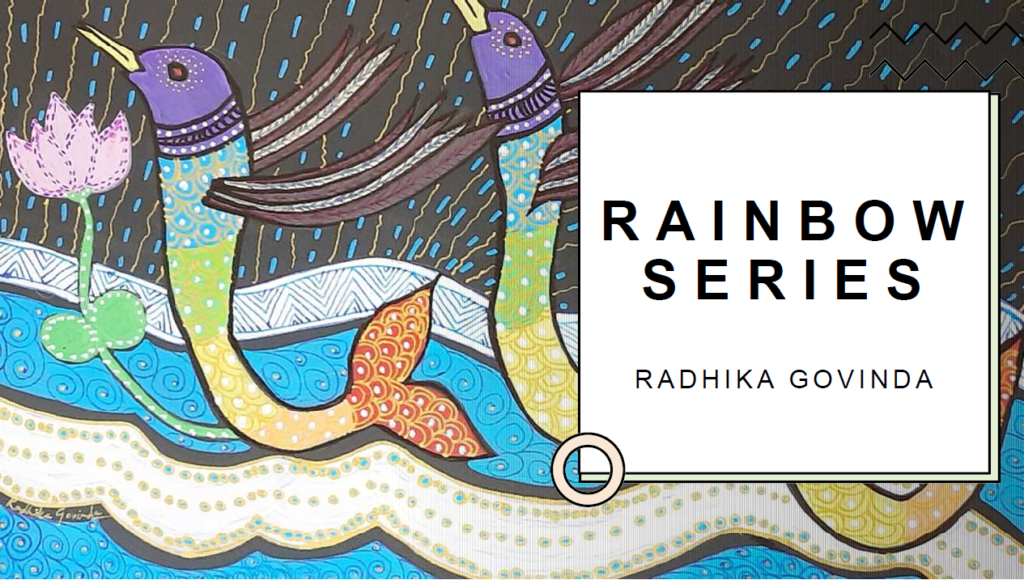

As the days and weeks passed, and as nurseries closed and schools moved teaching online, drawings and paintings of rainbows started to come up on our street, on the neighbouring streets, and as it would turn out, all over the UK, as if signalling that everything was going to be okay, that a beautiful rainbow awaits us at the end of this storm that is the covid-19 pandemic.
My 4.5 year old and I too made a rainbow and put it up on our living room window. As the pandemic has stretched on, we have made several more, and now every window in our home is adorned with a handmade rainbow.
In the first instance, it is these rainbows that inspired this series of artwork, as I painted alongside my child. Hence the use of the seven colours of the rainbow in each piece.
Soon what I loosely call ‘painting’ became a creative outlet for the gamut of feelings I was experiencing – fear, anger, frustration, anxiety – and seeking – hope, resilience, comfort, calm. It helped get over migraines brought on by the stress of unending spirals of work and of anxiety about my family’s and my own wellbeing that even multiple doses of paracetamol couldn’t resolve. It enabled me to express the snatches of thoughts I struggled to coherently articulate in words, especially in those early days of the pandemic. Painting was cathartic. It was relaxing. It feels like a long-lost friend I have reconnected with after the passage of many years. Why did we ever drift apart? Painting has been a lifeline in these disturbing times.

But I am no artist. If you asked me about my distinct style, I would say that I don’t have one. What I have attempted with ordinary acrylic paint pens in this series is an amalgam inspired by gond, madhubani and tinga tinga artists and art forms.
There are seven pieces of artwork in this series. The symbolism of the rainbow or the seven colours of the rainbow appear in each piece. Over the next seven days, I will post one piece and accompanying reflections every day, in keeping with the symbolism of the seven colours of the rainbow.

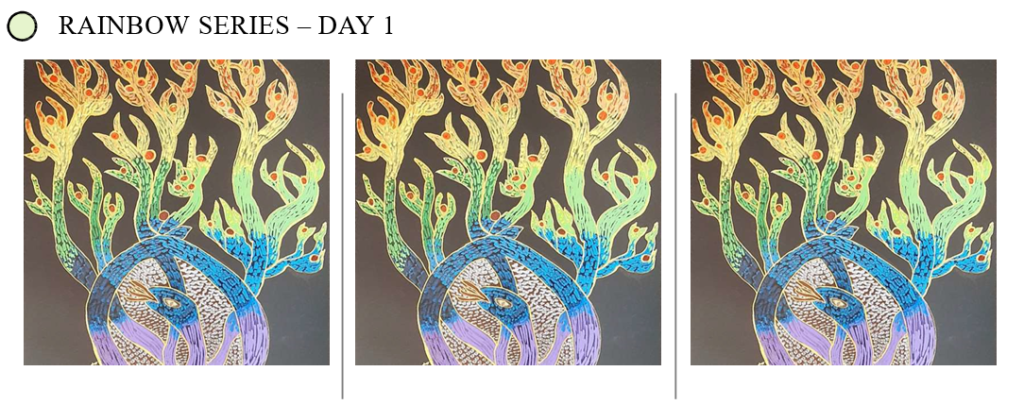
Today’s artwork is titled: ‘Anthropocene’.
The Australian bushfires just before, and the oil leak in the Arctic circle, the recurring earthquakes, swarms of locusts and devastating cyclones in the South Asian subcontinent during the ongoing pandemic are all manifestations of climate change. Is the pandemic nature’s way of disrupting the world’s march towards unbridled capitalism? Is it the warning that we, as humankind, must heed if we are to survive?

Anthropocene/
The serpent carries within her the earth.
The tree of life grows on her.
Disturb her, and life as we know it is shaken.
Inspired by Ram Singh Urveti’s ‘The Tree of the Serpent Goddess’ from Bajju Shyam, Durga Bai and Ram Singh Urveti’s (2006) The Night Life of Trees, Chennai: Tara Books.

Radhika Govinda is a feminist sociologist whose work is on the gender politics of development, intersectionality and feminist knowledge production. She lives and works in Edinburgh, and can be reached at Radhika.Govinda@ed.ac.uk. Twitter: @GovindaRadhika
